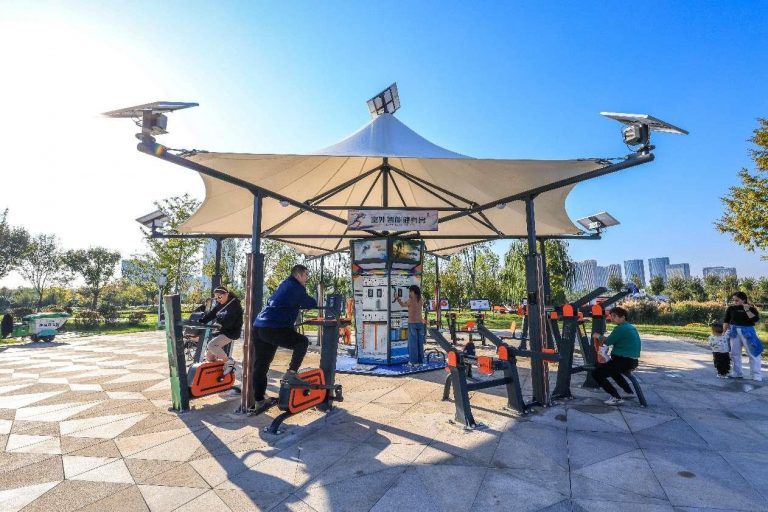
By Liu Leyi, Intelligent technology is playing an increasingly vital role in enhancing competitive sports, enriching fitness products for the public, and accelerating sports-education integration.
For instance, AI models were employed by athletes in their preparation for the Olympic Games, and big data technology is used to gain deeper insights into athletes’ performance in routine training.
Additionally, smart and convenient fitness equipment has become increasingly prevalent, while advanced physical education analysis systems are widely adopted to optimize training programs.
These innovations are propelling China’s sports industry into a new era marked by intelligent development.
In a 50-meter-long swimming pool, 16 underwater cameras are placed every three meters from start to finish. The moment an athlete enters the water, the cameras automatically capture every movement the athlete performs, recording detailed progress by the second.
Then, AI technology seamlessly stitches the frames together, creating a comprehensive image of the swimmer’s trajectory.
Behind this innovative “panorama” lies the technological support of a sports large model developed by a collaboration between Shanghai University of Sport, tech firm Baidu, and Shanghai University. The large model is the first one in China tailored to the sports industry.
“This large model was developed with motion recognition and analysis as the basis,” said Professor Li Yongming from Shanghai University of Sport. According to Li, the large model has been adopted by multiple national teams, such as diving, swimming, track and field, gymnastics, trampolining, and climbing.
The national swimming team has built an AI-assisted training system powered by the large model, which functions like an “intelligent coach.” By capturing intricate details of athletes’ movements, the system identifies aspects for improvement. Using feedback data from the system, coaches can adjust training strategies, while athletes gain a clearer understanding of their progress.
“Starting with competitive sports, we’ve accumulated extensive algorithms and techniques related to human movement,” said Li, adding this large model will expand its applications beyond competitive sports to areas like public fitness and sports rehabilitation.
In Beijing’s Haidian Park, runners can be seen dashing along a red smart track, while nearby intelligent screens display real-time updates of their fitness data, including calories burned, speed, and stride frequency – all at a glance.
A local resident surnamed Wang said that the track, powered by facial recognition technology, is like a “smart companion” that records his workout data in real time.
“Running has become more purposeful for me now – I look forward to seeing my progress every day,” he said.
Over at Ritan Park, or Temple of the Sun Park, sports facilities have been transformed into a fully equipped “outdoor smart gym.” “These machines come with exercise guides and workout recommendations. The electronic screens show details like exercise duration and calories burned, which is incredibly helpful for fitness enthusiasts like me,” said Chen, a “devoted fan” of smart fitness equipment.
In recent years, smart sports parks have been established in a number of cities across China, making fitness activities more and more intelligent.
Huo Bo, director of the Institute of Artificial Intelligence in Sports at Capital University of Physical Education and Sports, said: “By using smart devices to monitor exercise data in real time and provide personalized suggestions, citizens can make fitness activities more efficient. This not only enhances the effectiveness of public fitness programs but also improves overall quality of life. The integration of smart technology with sports represents both technological progress and a critical step toward promoting public health.”
Today, some primary and secondary schools are integrating smart technologies into physical education classes, infusing new momentum into campus sports education through the power of technology.
At Beijing No. 18 Middle School, students lined up on an AI-equipped track. At the sound of the starting signal, they sprinted off the line, while sensors precisely captured their speed and stride frequency. The data was displayed on an electronic screen, alongside their previous records for comparison. This allows each student to quickly understand their progress while helping teachers better analyze their performance and predict their developmental trends.










